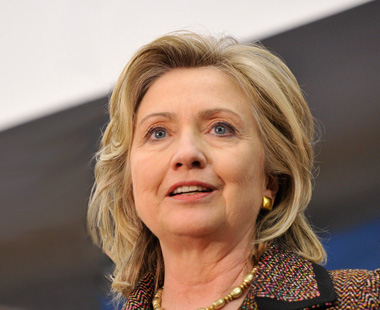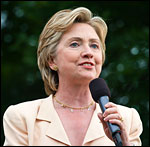Update: Clinton suspended her campaign for the presidency on June 7, 2008.
During her years representing New York state in the U.S. Senate (2001 to the present), Hillary Clinton has earned an 87 percent lifetime voting score from the League of Conservation Voters (lower than it might have been because she’s missed some votes while campaigning for president). She has tended to run with the Democratic pack on environmental policy, but in November 2007 she unveiled a comprehensive and ambitious climate and energy plan.
Read an interview with Hillary Clinton by Grist and Outside.
Key Points
- Proposes a Strategic Energy Fund that would raise $50 billion over 10 years by taxing the “excess profits” of oil companies and cutting their tax breaks. The money would be invested in “clean energy technologies,” including renewable energy, energy efficiency, “clean coal,” plug-in hybrids, cellulosic ethanol and other biofuels, and more. Clinton describes it as “an Apollo Project-like program dedicated to achieving energy independence.”
- Calls for cutting U.S. carbon dioxide emissions 80 percent below 1990 levels by 2050. Would accomplish this through a cap-and-trade system that would auction off 100 percent of emissions permits, making polluters pay for the CO2 they emit.
- Emphasizes the creation of “green-collar jobs” in the fields of clean energy and energy efficiency. Aims to create up to 5 million clean-energy jobs over the next decade.
- Made her campaign carbon-neutral in April 2007, one month after John Edwards did.
- Calls for the U.S. to cut its consumption of foreign oil by two-thirds of projected levels by 2030.
- Supports a goal to get 25 percent of the U.S. electricity supply from renewable sources by 2030.
- Supports raising fleet-wide fuel-economy standards to 40 miles per gallon by 2020 and 55 mpg by 2030.
- Has advocated for a summer “gas-tax holiday” to ease consumer prices at the pump. The proposal would suspend the 18-cent federal gasoline tax and 24-cent diesel tax from Memorial Day to Labor Day, to be paid for by a tax on oil-company profits.
- Supports coal-to-liquid fuels if they emit 20 percent less carbon over their lifecycle than conventional fuels. On June 19, 2007, voted in favor of an amendment that would provide loans for coal projects, including liquefied coal; the amendment did not pass.
Video and Audio
Watch Clinton explain her positions on climate change and energy issues at a Nov. 17, 2007, Grist-sponsored forum:
Watch a “Hillcast” from March 1, 2007, in which Clinton explains her energy vision:
[vodpod id=Video.49020&w=425&h=350&fv=%26rel%3D0%26border%3D0%26]
Watch Clinton discuss her energy plans on May 30, 2007, at a rally in Las Vegas:
[vodpod id=Video.16092202&w=425&h=350&fv=%26rel%3D0%26border%3D0%26]
Listen to a clip of Clinton’s interview with Grist and Outside:
Quotable Quotes
- “I know that we have got an important debate going on right now about how we are going to help families deal with these gas prices. They have gone up so fast, so out of sight in the minds of the people that I talk with and I think it’s time that we really had a concerted strategy. You’ve heard me say this and I’ll say it again. I think its time to give Americans a break this summer and to make the oil companies pay the gas tax out of their record profits.”
— May 6, 2008, in a victory speech in Indiana
- “We’re going to create at least 5 million additional jobs in green energy. Jobs making public buildings more energy efficient. Jobs weatherizing homes to make sure that people get more value for their dollar, to save on home heating and cooling bills. Jobs that will re-open shuttered factories to build the clean energy technologies.”
— April 1, 2008, in a speech to the Pennsylvania AFL-CIO
- “I am concerned about [mountaintop-removal mining] for all the reasons people state, but I think it’s a difficult question because of the conflict between the economic and environmental trade-off that you have here. I’m not an expert. I don’t know enough to have an independent opinion, but I sure would like people … to come up with some approach that would enable us to retrieve the coal but would enable us to do it in a way that wouldn’t damage the living standards and the other important qualities associated with people living both under the mountaintop and people who are along the streams. You know, maybe there is a way to recover those mountaintops once they have been stripped of the coal.”
— March 19, 2008, in an interview with West Virginia Public Radio
- “The risks of inaction [on climate change], for those who still cling to the outmoded and disgraced view that there is no need for action, are abundantly clear. The consequences are so dire that this election has to focus on this issue. We cannot afford to fiddle while the world warms because we’ve already seen and we know conclusively what that will do to us.”
— Nov. 17, 2007, speaking in Los Angeles at the Global Warming and America’s Energy Future forum sponsored by Grist
- “[O]ur values demand that we be good stewards of the planet for our children and our children’s children. We are failing that simple moral test if we continue to stand by as the Earth warms faster than at any time in the past 200,000 years. … We can fix these problems together by changing to a clean energy future fueled by innovation and efficiency.”
— May 23, 2006, in a speech on energy policy delivered at the National Press Club

